BUACC5931 Assignment: Associations of Job Insecurity and Well-being
VerifiedAdded on 2022/10/10
|10
|2586
|3
Homework Assignment
AI Summary
This assignment analyzes a study on the associations between quantitative and qualitative job insecurity and employee well-being within the Belgian banking sector. The analysis begins by evaluating the sample size of 15,000 employees (21% of the population), discussing its necessity, and considering potential costs and data management issues. The current cluster sampling method is then examined, highlighting its advantages (cost-effectiveness, representativeness, and wide coverage) and disadvantages (potential bias, sampling errors, and limitations to specific population groups). The reliability and validity of the study's measures for variables such as job security, psychological distress, and social demographics (gender, age, education, extra income) are assessed. Furthermore, the purpose of collecting social demographic data is discussed, emphasizing its role in classification, detailed analysis, and the creation of control variables. Finally, the correlational research design is identified, with its strengths (identifying variable relationships, large sample sizes, and naturalistic behavior) and weaknesses (inability to establish cause-effect, limitations in depicting non-linear relationships, and potential for skewed results) are evaluated. The assignment provides a comprehensive overview of the research methodology and its implications for understanding the impact of job insecurity on employee well-being.
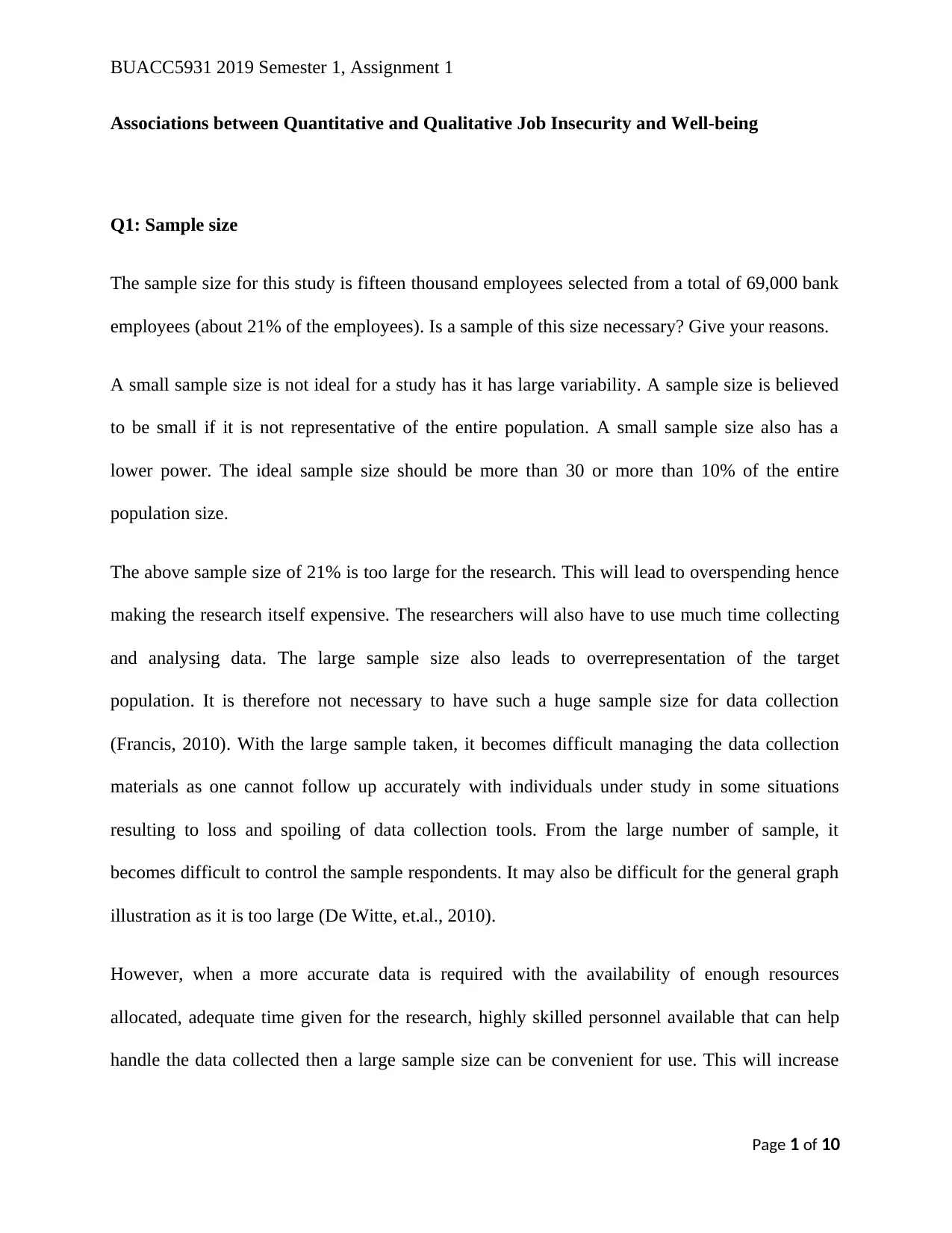
BUACC5931 2019 Semester 1, Assignment 1
Associations between Quantitative and Qualitative Job Insecurity and Well-being
Q1: Sample size
The sample size for this study is fifteen thousand employees selected from a total of 69,000 bank
employees (about 21% of the employees). Is a sample of this size necessary? Give your reasons.
A small sample size is not ideal for a study has it has large variability. A sample size is believed
to be small if it is not representative of the entire population. A small sample size also has a
lower power. The ideal sample size should be more than 30 or more than 10% of the entire
population size.
The above sample size of 21% is too large for the research. This will lead to overspending hence
making the research itself expensive. The researchers will also have to use much time collecting
and analysing data. The large sample size also leads to overrepresentation of the target
population. It is therefore not necessary to have such a huge sample size for data collection
(Francis, 2010). With the large sample taken, it becomes difficult managing the data collection
materials as one cannot follow up accurately with individuals under study in some situations
resulting to loss and spoiling of data collection tools. From the large number of sample, it
becomes difficult to control the sample respondents. It may also be difficult for the general graph
illustration as it is too large (De Witte, et.al., 2010).
However, when a more accurate data is required with the availability of enough resources
allocated, adequate time given for the research, highly skilled personnel available that can help
handle the data collected then a large sample size can be convenient for use. This will increase
Page 1 of 10
Associations between Quantitative and Qualitative Job Insecurity and Well-being
Q1: Sample size
The sample size for this study is fifteen thousand employees selected from a total of 69,000 bank
employees (about 21% of the employees). Is a sample of this size necessary? Give your reasons.
A small sample size is not ideal for a study has it has large variability. A sample size is believed
to be small if it is not representative of the entire population. A small sample size also has a
lower power. The ideal sample size should be more than 30 or more than 10% of the entire
population size.
The above sample size of 21% is too large for the research. This will lead to overspending hence
making the research itself expensive. The researchers will also have to use much time collecting
and analysing data. The large sample size also leads to overrepresentation of the target
population. It is therefore not necessary to have such a huge sample size for data collection
(Francis, 2010). With the large sample taken, it becomes difficult managing the data collection
materials as one cannot follow up accurately with individuals under study in some situations
resulting to loss and spoiling of data collection tools. From the large number of sample, it
becomes difficult to control the sample respondents. It may also be difficult for the general graph
illustration as it is too large (De Witte, et.al., 2010).
However, when a more accurate data is required with the availability of enough resources
allocated, adequate time given for the research, highly skilled personnel available that can help
handle the data collected then a large sample size can be convenient for use. This will increase
Page 1 of 10
Paraphrase This Document
Need a fresh take? Get an instant paraphrase of this document with our AI Paraphraser
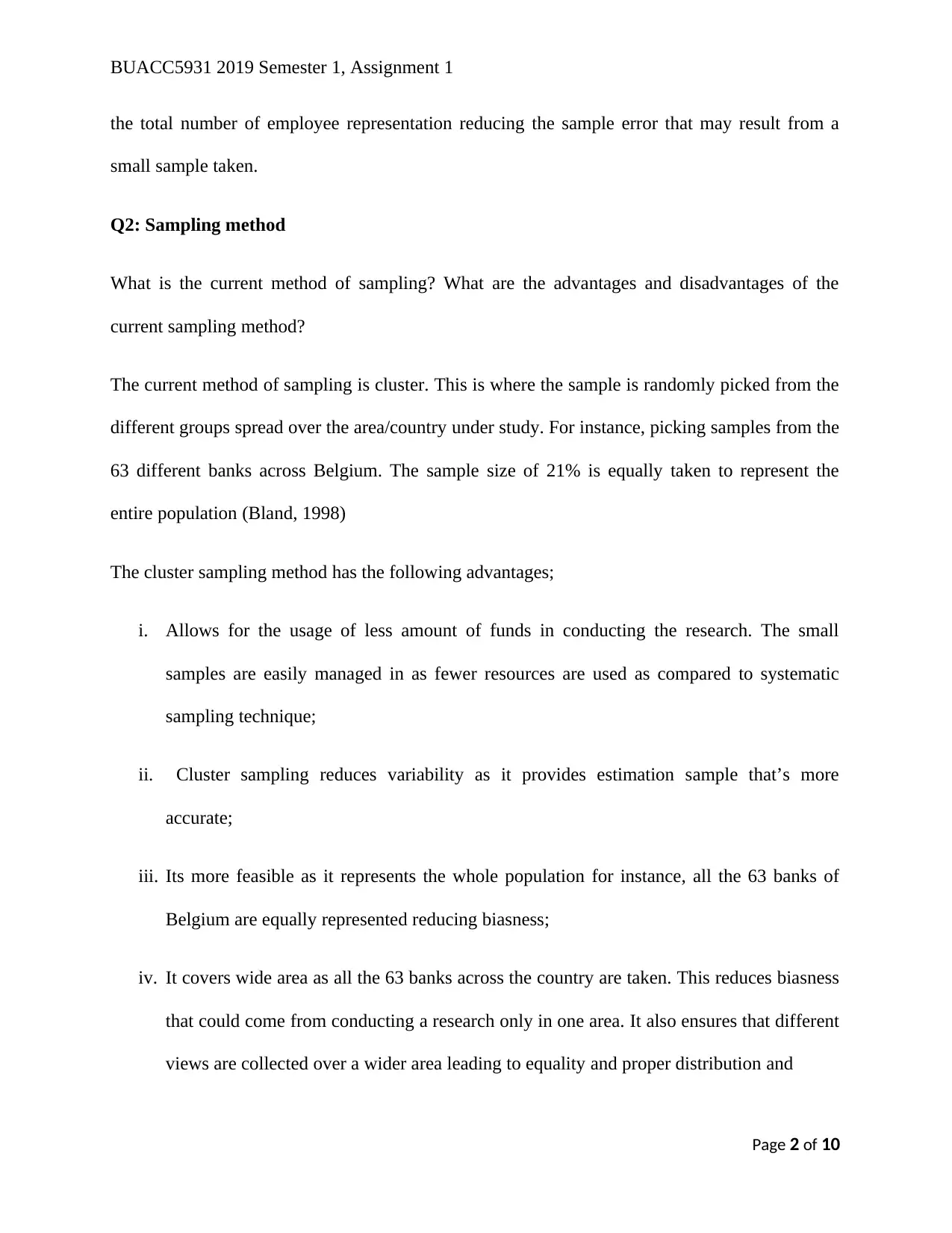
BUACC5931 2019 Semester 1, Assignment 1
the total number of employee representation reducing the sample error that may result from a
small sample taken.
Q2: Sampling method
What is the current method of sampling? What are the advantages and disadvantages of the
current sampling method?
The current method of sampling is cluster. This is where the sample is randomly picked from the
different groups spread over the area/country under study. For instance, picking samples from the
63 different banks across Belgium. The sample size of 21% is equally taken to represent the
entire population (Bland, 1998)
The cluster sampling method has the following advantages;
i. Allows for the usage of less amount of funds in conducting the research. The small
samples are easily managed in as fewer resources are used as compared to systematic
sampling technique;
ii. Cluster sampling reduces variability as it provides estimation sample that’s more
accurate;
iii. Its more feasible as it represents the whole population for instance, all the 63 banks of
Belgium are equally represented reducing biasness;
iv. It covers wide area as all the 63 banks across the country are taken. This reduces biasness
that could come from conducting a research only in one area. It also ensures that different
views are collected over a wider area leading to equality and proper distribution and
Page 2 of 10
the total number of employee representation reducing the sample error that may result from a
small sample taken.
Q2: Sampling method
What is the current method of sampling? What are the advantages and disadvantages of the
current sampling method?
The current method of sampling is cluster. This is where the sample is randomly picked from the
different groups spread over the area/country under study. For instance, picking samples from the
63 different banks across Belgium. The sample size of 21% is equally taken to represent the
entire population (Bland, 1998)
The cluster sampling method has the following advantages;
i. Allows for the usage of less amount of funds in conducting the research. The small
samples are easily managed in as fewer resources are used as compared to systematic
sampling technique;
ii. Cluster sampling reduces variability as it provides estimation sample that’s more
accurate;
iii. Its more feasible as it represents the whole population for instance, all the 63 banks of
Belgium are equally represented reducing biasness;
iv. It covers wide area as all the 63 banks across the country are taken. This reduces biasness
that could come from conducting a research only in one area. It also ensures that different
views are collected over a wider area leading to equality and proper distribution and
Page 2 of 10
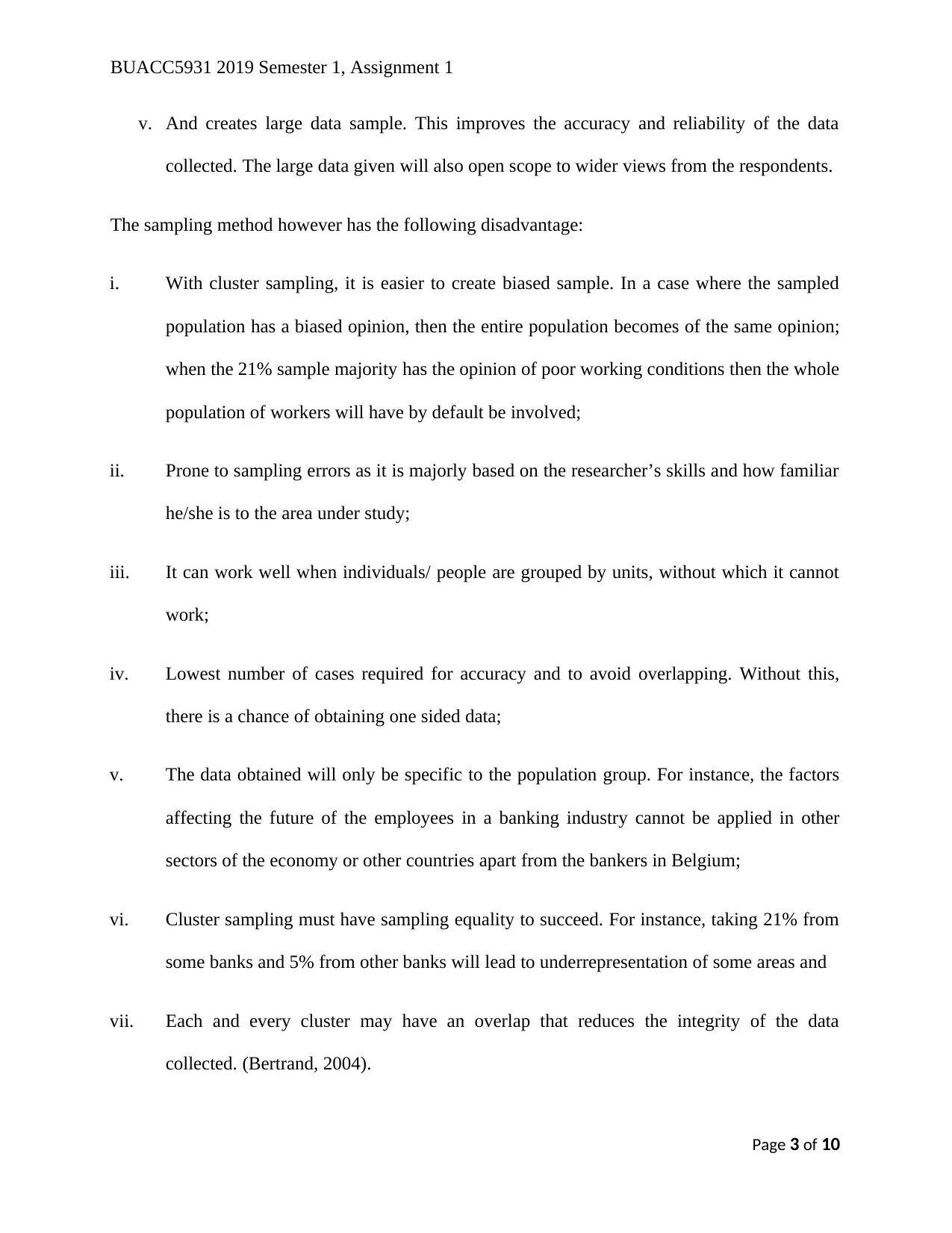
BUACC5931 2019 Semester 1, Assignment 1
v. And creates large data sample. This improves the accuracy and reliability of the data
collected. The large data given will also open scope to wider views from the respondents.
The sampling method however has the following disadvantage:
i. With cluster sampling, it is easier to create biased sample. In a case where the sampled
population has a biased opinion, then the entire population becomes of the same opinion;
when the 21% sample majority has the opinion of poor working conditions then the whole
population of workers will have by default be involved;
ii. Prone to sampling errors as it is majorly based on the researcher’s skills and how familiar
he/she is to the area under study;
iii. It can work well when individuals/ people are grouped by units, without which it cannot
work;
iv. Lowest number of cases required for accuracy and to avoid overlapping. Without this,
there is a chance of obtaining one sided data;
v. The data obtained will only be specific to the population group. For instance, the factors
affecting the future of the employees in a banking industry cannot be applied in other
sectors of the economy or other countries apart from the bankers in Belgium;
vi. Cluster sampling must have sampling equality to succeed. For instance, taking 21% from
some banks and 5% from other banks will lead to underrepresentation of some areas and
vii. Each and every cluster may have an overlap that reduces the integrity of the data
collected. (Bertrand, 2004).
Page 3 of 10
v. And creates large data sample. This improves the accuracy and reliability of the data
collected. The large data given will also open scope to wider views from the respondents.
The sampling method however has the following disadvantage:
i. With cluster sampling, it is easier to create biased sample. In a case where the sampled
population has a biased opinion, then the entire population becomes of the same opinion;
when the 21% sample majority has the opinion of poor working conditions then the whole
population of workers will have by default be involved;
ii. Prone to sampling errors as it is majorly based on the researcher’s skills and how familiar
he/she is to the area under study;
iii. It can work well when individuals/ people are grouped by units, without which it cannot
work;
iv. Lowest number of cases required for accuracy and to avoid overlapping. Without this,
there is a chance of obtaining one sided data;
v. The data obtained will only be specific to the population group. For instance, the factors
affecting the future of the employees in a banking industry cannot be applied in other
sectors of the economy or other countries apart from the bankers in Belgium;
vi. Cluster sampling must have sampling equality to succeed. For instance, taking 21% from
some banks and 5% from other banks will lead to underrepresentation of some areas and
vii. Each and every cluster may have an overlap that reduces the integrity of the data
collected. (Bertrand, 2004).
Page 3 of 10
⊘ This is a preview!⊘
Do you want full access?
Subscribe today to unlock all pages.

Trusted by 1+ million students worldwide
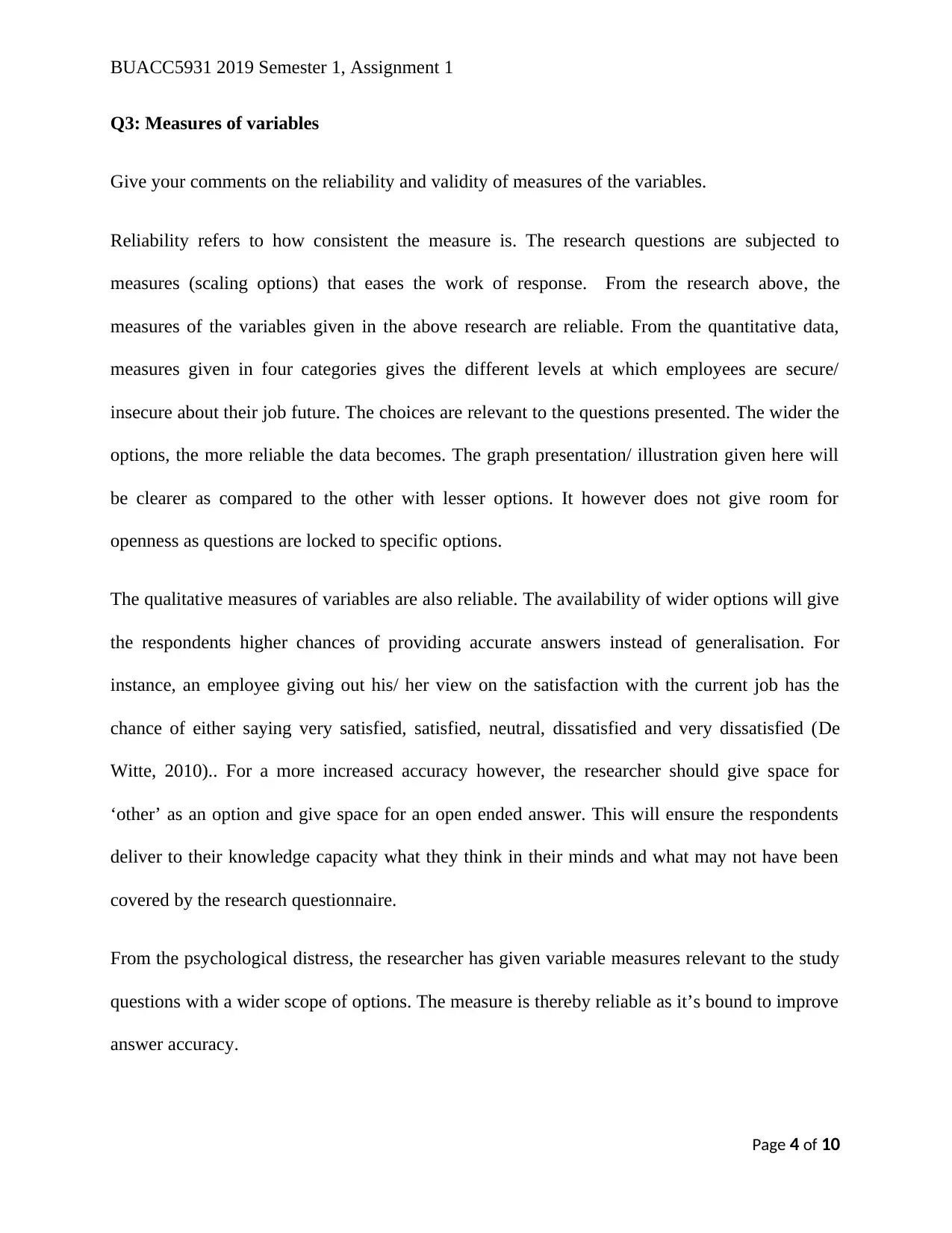
BUACC5931 2019 Semester 1, Assignment 1
Q3: Measures of variables
Give your comments on the reliability and validity of measures of the variables.
Reliability refers to how consistent the measure is. The research questions are subjected to
measures (scaling options) that eases the work of response. From the research above, the
measures of the variables given in the above research are reliable. From the quantitative data,
measures given in four categories gives the different levels at which employees are secure/
insecure about their job future. The choices are relevant to the questions presented. The wider the
options, the more reliable the data becomes. The graph presentation/ illustration given here will
be clearer as compared to the other with lesser options. It however does not give room for
openness as questions are locked to specific options.
The qualitative measures of variables are also reliable. The availability of wider options will give
the respondents higher chances of providing accurate answers instead of generalisation. For
instance, an employee giving out his/ her view on the satisfaction with the current job has the
chance of either saying very satisfied, satisfied, neutral, dissatisfied and very dissatisfied (De
Witte, 2010).. For a more increased accuracy however, the researcher should give space for
‘other’ as an option and give space for an open ended answer. This will ensure the respondents
deliver to their knowledge capacity what they think in their minds and what may not have been
covered by the research questionnaire.
From the psychological distress, the researcher has given variable measures relevant to the study
questions with a wider scope of options. The measure is thereby reliable as it’s bound to improve
answer accuracy.
Page 4 of 10
Q3: Measures of variables
Give your comments on the reliability and validity of measures of the variables.
Reliability refers to how consistent the measure is. The research questions are subjected to
measures (scaling options) that eases the work of response. From the research above, the
measures of the variables given in the above research are reliable. From the quantitative data,
measures given in four categories gives the different levels at which employees are secure/
insecure about their job future. The choices are relevant to the questions presented. The wider the
options, the more reliable the data becomes. The graph presentation/ illustration given here will
be clearer as compared to the other with lesser options. It however does not give room for
openness as questions are locked to specific options.
The qualitative measures of variables are also reliable. The availability of wider options will give
the respondents higher chances of providing accurate answers instead of generalisation. For
instance, an employee giving out his/ her view on the satisfaction with the current job has the
chance of either saying very satisfied, satisfied, neutral, dissatisfied and very dissatisfied (De
Witte, 2010).. For a more increased accuracy however, the researcher should give space for
‘other’ as an option and give space for an open ended answer. This will ensure the respondents
deliver to their knowledge capacity what they think in their minds and what may not have been
covered by the research questionnaire.
From the psychological distress, the researcher has given variable measures relevant to the study
questions with a wider scope of options. The measure is thereby reliable as it’s bound to improve
answer accuracy.
Page 4 of 10
Paraphrase This Document
Need a fresh take? Get an instant paraphrase of this document with our AI Paraphraser
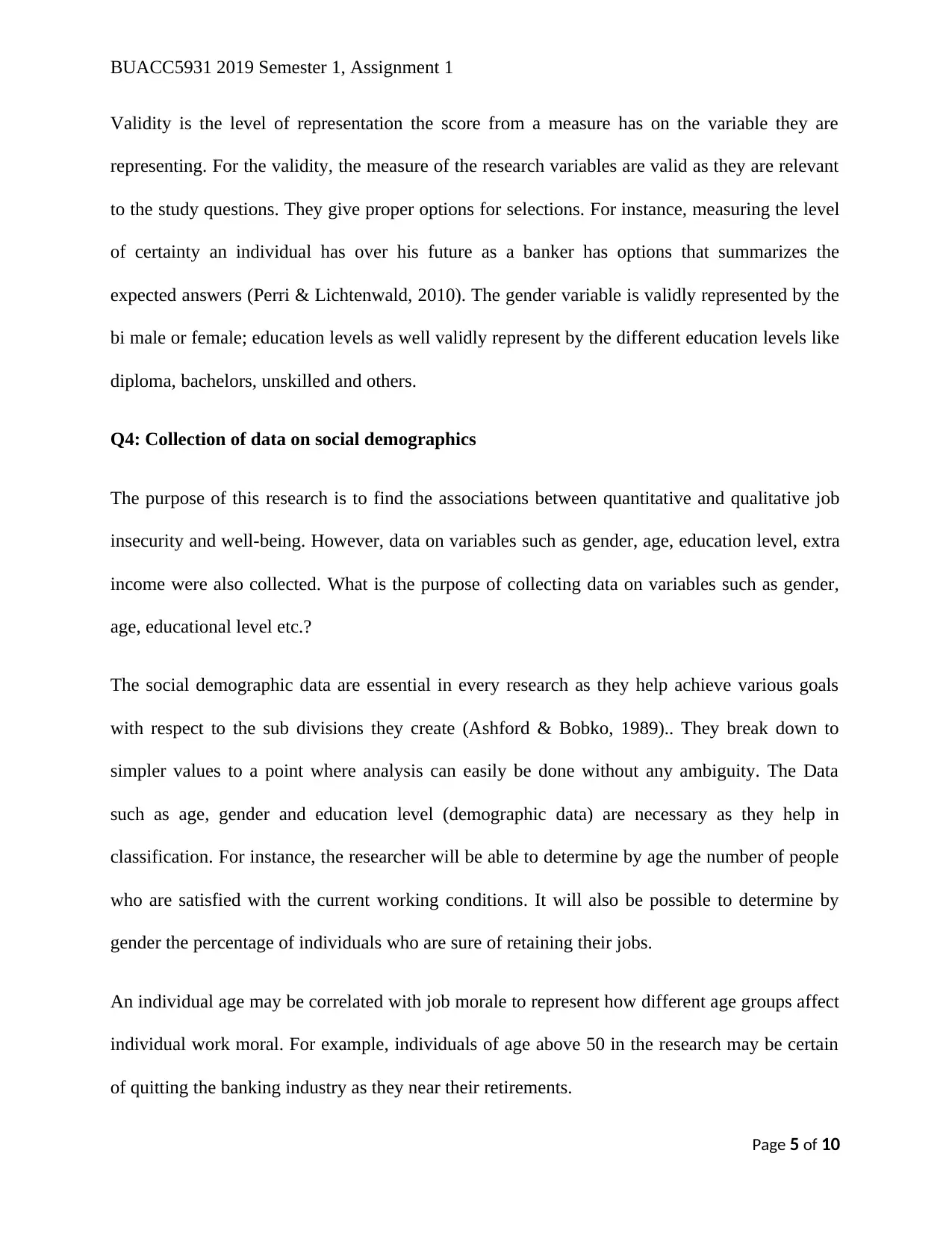
BUACC5931 2019 Semester 1, Assignment 1
Validity is the level of representation the score from a measure has on the variable they are
representing. For the validity, the measure of the research variables are valid as they are relevant
to the study questions. They give proper options for selections. For instance, measuring the level
of certainty an individual has over his future as a banker has options that summarizes the
expected answers (Perri & Lichtenwald, 2010). The gender variable is validly represented by the
bi male or female; education levels as well validly represent by the different education levels like
diploma, bachelors, unskilled and others.
Q4: Collection of data on social demographics
The purpose of this research is to find the associations between quantitative and qualitative job
insecurity and well-being. However, data on variables such as gender, age, education level, extra
income were also collected. What is the purpose of collecting data on variables such as gender,
age, educational level etc.?
The social demographic data are essential in every research as they help achieve various goals
with respect to the sub divisions they create (Ashford & Bobko, 1989).. They break down to
simpler values to a point where analysis can easily be done without any ambiguity. The Data
such as age, gender and education level (demographic data) are necessary as they help in
classification. For instance, the researcher will be able to determine by age the number of people
who are satisfied with the current working conditions. It will also be possible to determine by
gender the percentage of individuals who are sure of retaining their jobs.
An individual age may be correlated with job morale to represent how different age groups affect
individual work moral. For example, individuals of age above 50 in the research may be certain
of quitting the banking industry as they near their retirements.
Page 5 of 10
Validity is the level of representation the score from a measure has on the variable they are
representing. For the validity, the measure of the research variables are valid as they are relevant
to the study questions. They give proper options for selections. For instance, measuring the level
of certainty an individual has over his future as a banker has options that summarizes the
expected answers (Perri & Lichtenwald, 2010). The gender variable is validly represented by the
bi male or female; education levels as well validly represent by the different education levels like
diploma, bachelors, unskilled and others.
Q4: Collection of data on social demographics
The purpose of this research is to find the associations between quantitative and qualitative job
insecurity and well-being. However, data on variables such as gender, age, education level, extra
income were also collected. What is the purpose of collecting data on variables such as gender,
age, educational level etc.?
The social demographic data are essential in every research as they help achieve various goals
with respect to the sub divisions they create (Ashford & Bobko, 1989).. They break down to
simpler values to a point where analysis can easily be done without any ambiguity. The Data
such as age, gender and education level (demographic data) are necessary as they help in
classification. For instance, the researcher will be able to determine by age the number of people
who are satisfied with the current working conditions. It will also be possible to determine by
gender the percentage of individuals who are sure of retaining their jobs.
An individual age may be correlated with job morale to represent how different age groups affect
individual work moral. For example, individuals of age above 50 in the research may be certain
of quitting the banking industry as they near their retirements.
Page 5 of 10
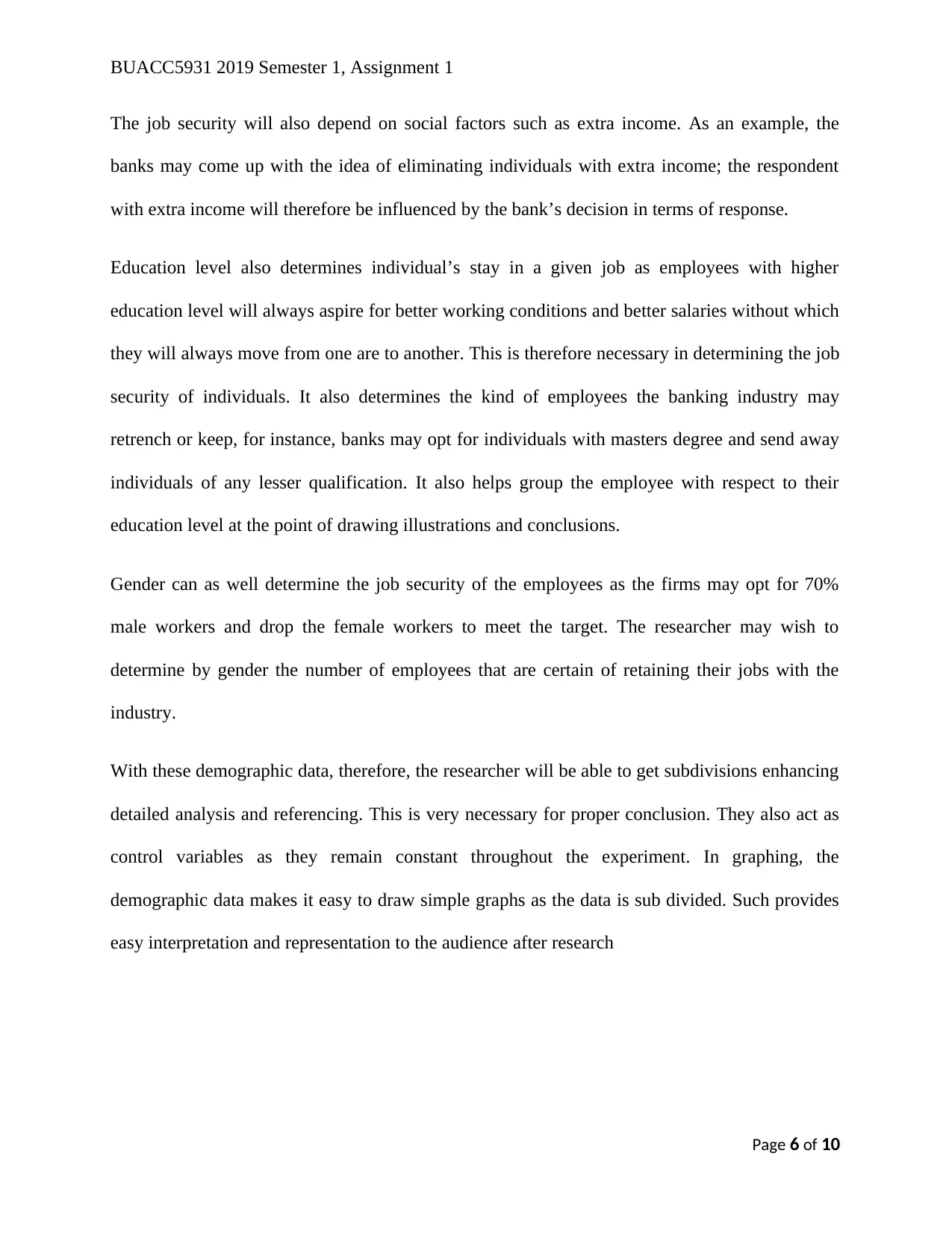
BUACC5931 2019 Semester 1, Assignment 1
The job security will also depend on social factors such as extra income. As an example, the
banks may come up with the idea of eliminating individuals with extra income; the respondent
with extra income will therefore be influenced by the bank’s decision in terms of response.
Education level also determines individual’s stay in a given job as employees with higher
education level will always aspire for better working conditions and better salaries without which
they will always move from one are to another. This is therefore necessary in determining the job
security of individuals. It also determines the kind of employees the banking industry may
retrench or keep, for instance, banks may opt for individuals with masters degree and send away
individuals of any lesser qualification. It also helps group the employee with respect to their
education level at the point of drawing illustrations and conclusions.
Gender can as well determine the job security of the employees as the firms may opt for 70%
male workers and drop the female workers to meet the target. The researcher may wish to
determine by gender the number of employees that are certain of retaining their jobs with the
industry.
With these demographic data, therefore, the researcher will be able to get subdivisions enhancing
detailed analysis and referencing. This is very necessary for proper conclusion. They also act as
control variables as they remain constant throughout the experiment. In graphing, the
demographic data makes it easy to draw simple graphs as the data is sub divided. Such provides
easy interpretation and representation to the audience after research
Page 6 of 10
The job security will also depend on social factors such as extra income. As an example, the
banks may come up with the idea of eliminating individuals with extra income; the respondent
with extra income will therefore be influenced by the bank’s decision in terms of response.
Education level also determines individual’s stay in a given job as employees with higher
education level will always aspire for better working conditions and better salaries without which
they will always move from one are to another. This is therefore necessary in determining the job
security of individuals. It also determines the kind of employees the banking industry may
retrench or keep, for instance, banks may opt for individuals with masters degree and send away
individuals of any lesser qualification. It also helps group the employee with respect to their
education level at the point of drawing illustrations and conclusions.
Gender can as well determine the job security of the employees as the firms may opt for 70%
male workers and drop the female workers to meet the target. The researcher may wish to
determine by gender the number of employees that are certain of retaining their jobs with the
industry.
With these demographic data, therefore, the researcher will be able to get subdivisions enhancing
detailed analysis and referencing. This is very necessary for proper conclusion. They also act as
control variables as they remain constant throughout the experiment. In graphing, the
demographic data makes it easy to draw simple graphs as the data is sub divided. Such provides
easy interpretation and representation to the audience after research
Page 6 of 10
⊘ This is a preview!⊘
Do you want full access?
Subscribe today to unlock all pages.

Trusted by 1+ million students worldwide
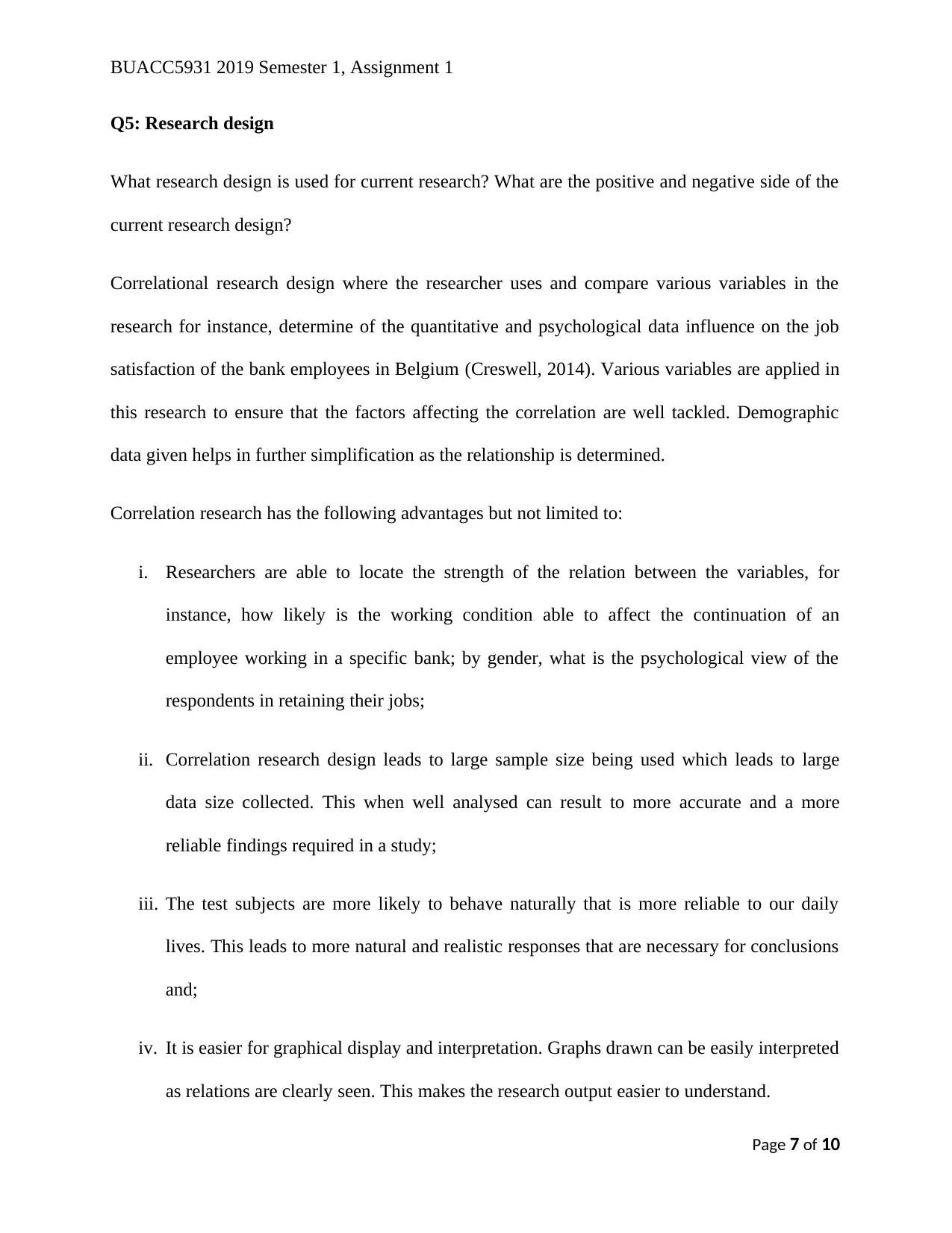
BUACC5931 2019 Semester 1, Assignment 1
Q5: Research design
What research design is used for current research? What are the positive and negative side of the
current research design?
Correlational research design where the researcher uses and compare various variables in the
research for instance, determine of the quantitative and psychological data influence on the job
satisfaction of the bank employees in Belgium (Creswell, 2014). Various variables are applied in
this research to ensure that the factors affecting the correlation are well tackled. Demographic
data given helps in further simplification as the relationship is determined.
Correlation research has the following advantages but not limited to:
i. Researchers are able to locate the strength of the relation between the variables, for
instance, how likely is the working condition able to affect the continuation of an
employee working in a specific bank; by gender, what is the psychological view of the
respondents in retaining their jobs;
ii. Correlation research design leads to large sample size being used which leads to large
data size collected. This when well analysed can result to more accurate and a more
reliable findings required in a study;
iii. The test subjects are more likely to behave naturally that is more reliable to our daily
lives. This leads to more natural and realistic responses that are necessary for conclusions
and;
iv. It is easier for graphical display and interpretation. Graphs drawn can be easily interpreted
as relations are clearly seen. This makes the research output easier to understand.
Page 7 of 10
Q5: Research design
What research design is used for current research? What are the positive and negative side of the
current research design?
Correlational research design where the researcher uses and compare various variables in the
research for instance, determine of the quantitative and psychological data influence on the job
satisfaction of the bank employees in Belgium (Creswell, 2014). Various variables are applied in
this research to ensure that the factors affecting the correlation are well tackled. Demographic
data given helps in further simplification as the relationship is determined.
Correlation research has the following advantages but not limited to:
i. Researchers are able to locate the strength of the relation between the variables, for
instance, how likely is the working condition able to affect the continuation of an
employee working in a specific bank; by gender, what is the psychological view of the
respondents in retaining their jobs;
ii. Correlation research design leads to large sample size being used which leads to large
data size collected. This when well analysed can result to more accurate and a more
reliable findings required in a study;
iii. The test subjects are more likely to behave naturally that is more reliable to our daily
lives. This leads to more natural and realistic responses that are necessary for conclusions
and;
iv. It is easier for graphical display and interpretation. Graphs drawn can be easily interpreted
as relations are clearly seen. This makes the research output easier to understand.
Page 7 of 10
Paraphrase This Document
Need a fresh take? Get an instant paraphrase of this document with our AI Paraphraser
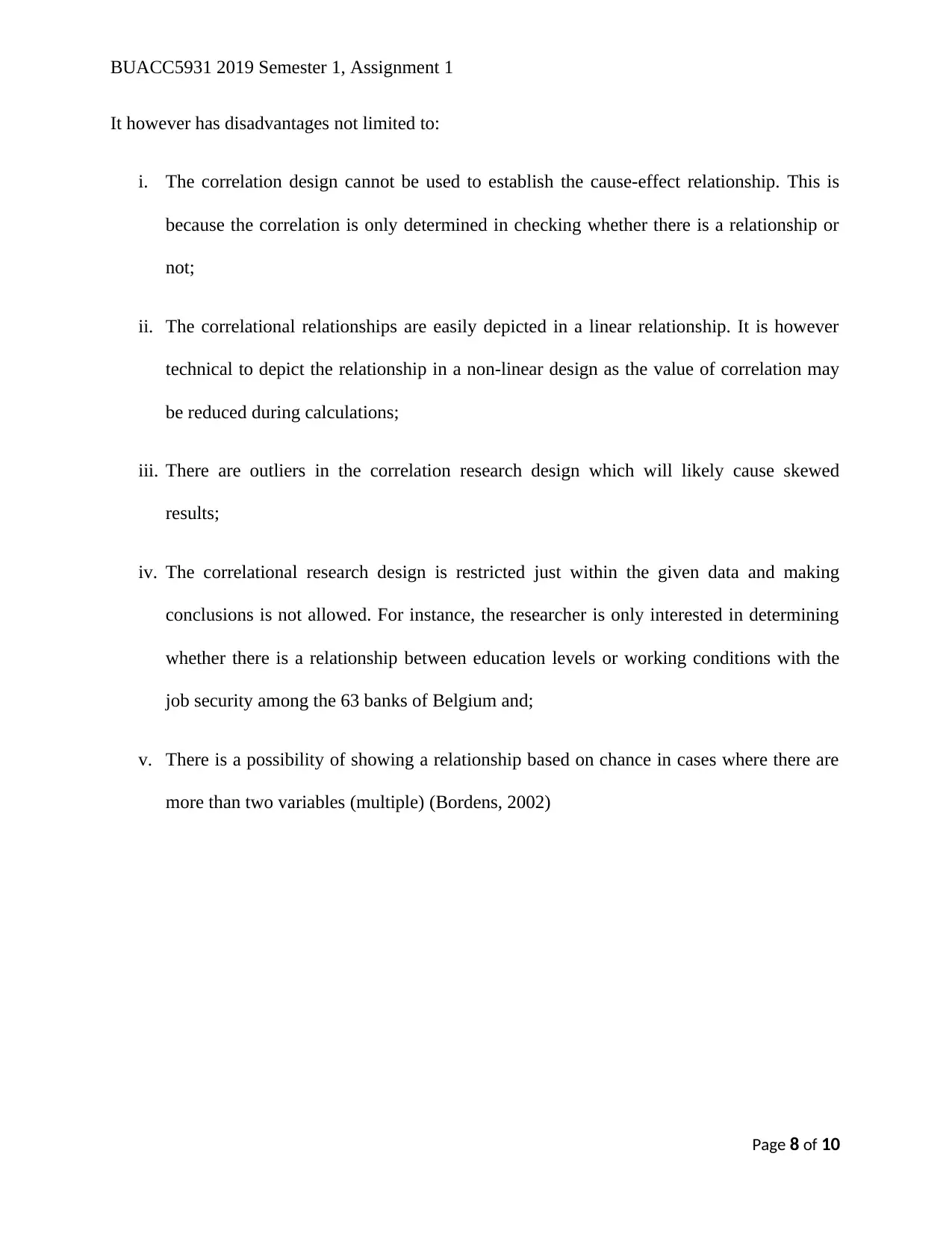
BUACC5931 2019 Semester 1, Assignment 1
It however has disadvantages not limited to:
i. The correlation design cannot be used to establish the cause-effect relationship. This is
because the correlation is only determined in checking whether there is a relationship or
not;
ii. The correlational relationships are easily depicted in a linear relationship. It is however
technical to depict the relationship in a non-linear design as the value of correlation may
be reduced during calculations;
iii. There are outliers in the correlation research design which will likely cause skewed
results;
iv. The correlational research design is restricted just within the given data and making
conclusions is not allowed. For instance, the researcher is only interested in determining
whether there is a relationship between education levels or working conditions with the
job security among the 63 banks of Belgium and;
v. There is a possibility of showing a relationship based on chance in cases where there are
more than two variables (multiple) (Bordens, 2002)
Page 8 of 10
It however has disadvantages not limited to:
i. The correlation design cannot be used to establish the cause-effect relationship. This is
because the correlation is only determined in checking whether there is a relationship or
not;
ii. The correlational relationships are easily depicted in a linear relationship. It is however
technical to depict the relationship in a non-linear design as the value of correlation may
be reduced during calculations;
iii. There are outliers in the correlation research design which will likely cause skewed
results;
iv. The correlational research design is restricted just within the given data and making
conclusions is not allowed. For instance, the researcher is only interested in determining
whether there is a relationship between education levels or working conditions with the
job security among the 63 banks of Belgium and;
v. There is a possibility of showing a relationship based on chance in cases where there are
more than two variables (multiple) (Bordens, 2002)
Page 8 of 10
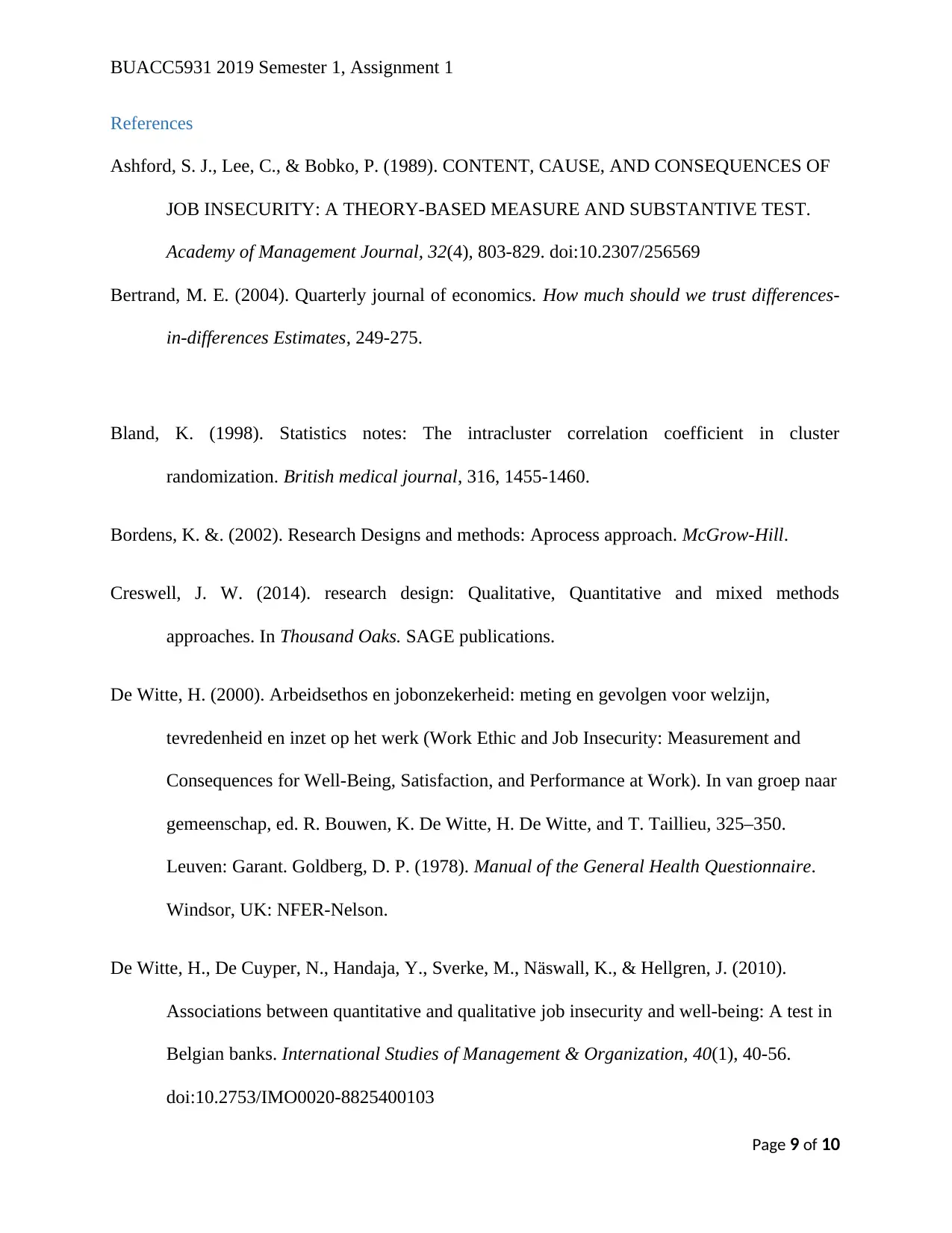
BUACC5931 2019 Semester 1, Assignment 1
References
Ashford, S. J., Lee, C., & Bobko, P. (1989). CONTENT, CAUSE, AND CONSEQUENCES OF
JOB INSECURITY: A THEORY-BASED MEASURE AND SUBSTANTIVE TEST.
Academy of Management Journal, 32(4), 803-829. doi:10.2307/256569
Bertrand, M. E. (2004). Quarterly journal of economics. How much should we trust differences-
in-differences Estimates, 249-275.
Bland, K. (1998). Statistics notes: The intracluster correlation coefficient in cluster
randomization. British medical journal, 316, 1455-1460.
Bordens, K. &. (2002). Research Designs and methods: Aprocess approach. McGrow-Hill.
Creswell, J. W. (2014). research design: Qualitative, Quantitative and mixed methods
approaches. In Thousand Oaks. SAGE publications.
De Witte, H. (2000). Arbeidsethos en jobonzekerheid: meting en gevolgen voor welzijn,
tevredenheid en inzet op het werk (Work Ethic and Job Insecurity: Measurement and
Consequences for Well-Being, Satisfaction, and Performance at Work). In van groep naar
gemeenschap, ed. R. Bouwen, K. De Witte, H. De Witte, and T. Taillieu, 325–350.
Leuven: Garant. Goldberg, D. P. (1978). Manual of the General Health Questionnaire.
Windsor, UK: NFER-Nelson.
De Witte, H., De Cuyper, N., Handaja, Y., Sverke, M., Näswall, K., & Hellgren, J. (2010).
Associations between quantitative and qualitative job insecurity and well-being: A test in
Belgian banks. International Studies of Management & Organization, 40(1), 40-56.
doi:10.2753/IMO0020-8825400103
Page 9 of 10
References
Ashford, S. J., Lee, C., & Bobko, P. (1989). CONTENT, CAUSE, AND CONSEQUENCES OF
JOB INSECURITY: A THEORY-BASED MEASURE AND SUBSTANTIVE TEST.
Academy of Management Journal, 32(4), 803-829. doi:10.2307/256569
Bertrand, M. E. (2004). Quarterly journal of economics. How much should we trust differences-
in-differences Estimates, 249-275.
Bland, K. (1998). Statistics notes: The intracluster correlation coefficient in cluster
randomization. British medical journal, 316, 1455-1460.
Bordens, K. &. (2002). Research Designs and methods: Aprocess approach. McGrow-Hill.
Creswell, J. W. (2014). research design: Qualitative, Quantitative and mixed methods
approaches. In Thousand Oaks. SAGE publications.
De Witte, H. (2000). Arbeidsethos en jobonzekerheid: meting en gevolgen voor welzijn,
tevredenheid en inzet op het werk (Work Ethic and Job Insecurity: Measurement and
Consequences for Well-Being, Satisfaction, and Performance at Work). In van groep naar
gemeenschap, ed. R. Bouwen, K. De Witte, H. De Witte, and T. Taillieu, 325–350.
Leuven: Garant. Goldberg, D. P. (1978). Manual of the General Health Questionnaire.
Windsor, UK: NFER-Nelson.
De Witte, H., De Cuyper, N., Handaja, Y., Sverke, M., Näswall, K., & Hellgren, J. (2010).
Associations between quantitative and qualitative job insecurity and well-being: A test in
Belgian banks. International Studies of Management & Organization, 40(1), 40-56.
doi:10.2753/IMO0020-8825400103
Page 9 of 10
⊘ This is a preview!⊘
Do you want full access?
Subscribe today to unlock all pages.

Trusted by 1+ million students worldwide
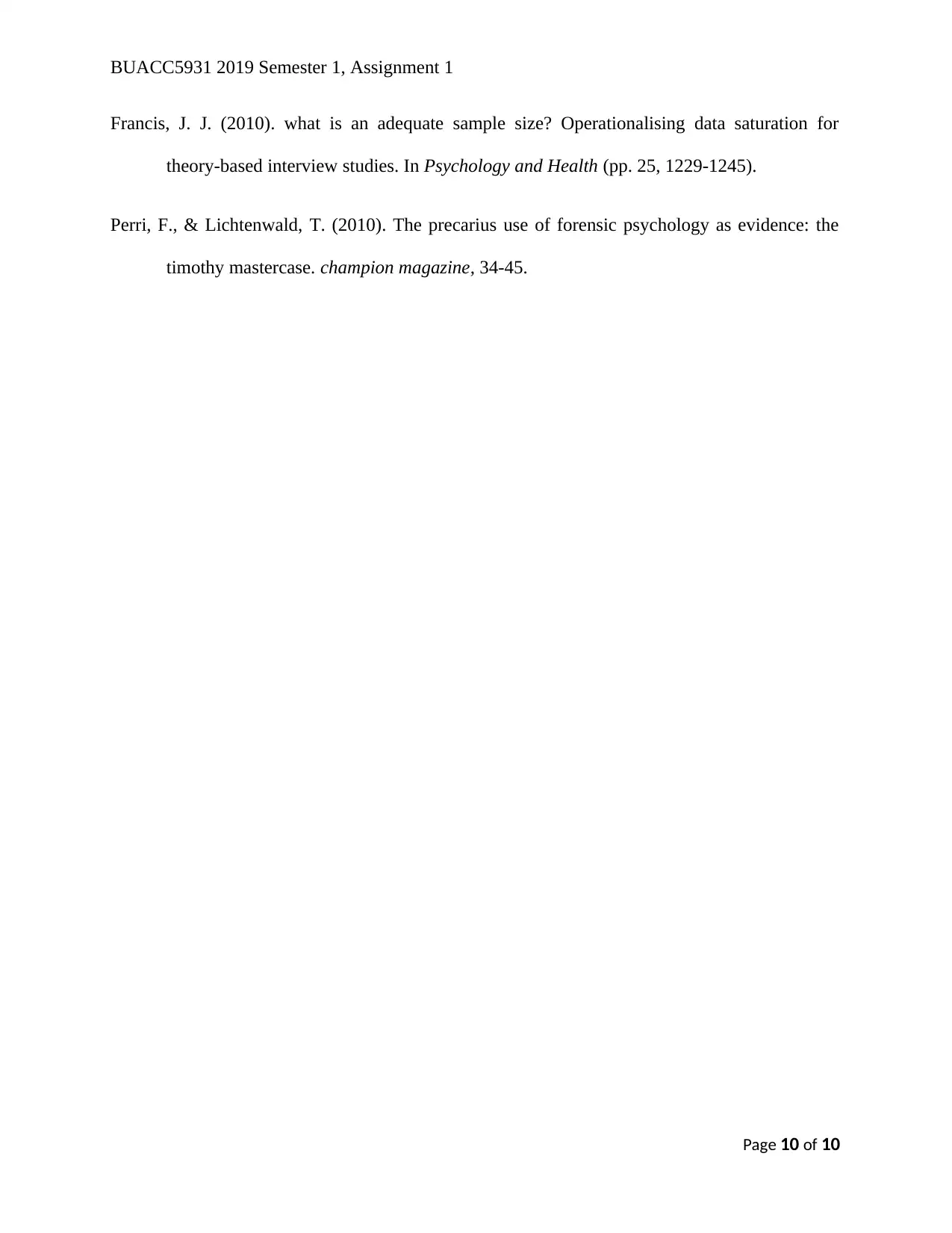
BUACC5931 2019 Semester 1, Assignment 1
Francis, J. J. (2010). what is an adequate sample size? Operationalising data saturation for
theory-based interview studies. In Psychology and Health (pp. 25, 1229-1245).
Perri, F., & Lichtenwald, T. (2010). The precarius use of forensic psychology as evidence: the
timothy mastercase. champion magazine, 34-45.
Page 10 of 10
Francis, J. J. (2010). what is an adequate sample size? Operationalising data saturation for
theory-based interview studies. In Psychology and Health (pp. 25, 1229-1245).
Perri, F., & Lichtenwald, T. (2010). The precarius use of forensic psychology as evidence: the
timothy mastercase. champion magazine, 34-45.
Page 10 of 10
1 out of 10
Related Documents
Your All-in-One AI-Powered Toolkit for Academic Success.
+13062052269
info@desklib.com
Available 24*7 on WhatsApp / Email
![[object Object]](/_next/static/media/star-bottom.7253800d.svg)
Unlock your academic potential
Copyright © 2020–2025 A2Z Services. All Rights Reserved. Developed and managed by ZUCOL.





